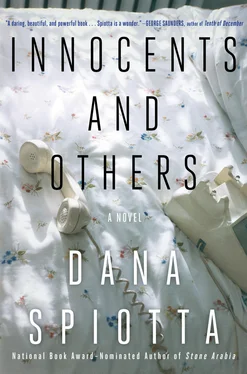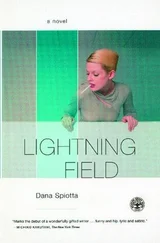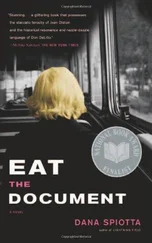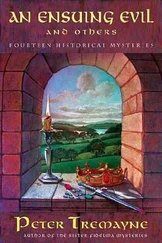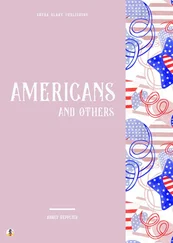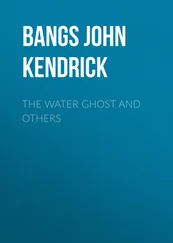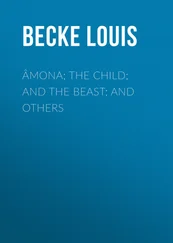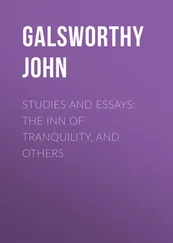Meadow wanted to track down and interview the girl in the famous photograph, but she discovered that it already had been done. Some TV show had the idea — the obvious, ordinary idea — to get the girl and the photographer together for a reunion.
Meadow decided to interview other people about the day. She wanted students, but she also wanted the National Guardsmen — the young men the same age as the students — who fired into the crowd.
Meadow would interview everyone in a plain room, a static space. She hated documentaries that showed people in their living rooms. Your thoughts became about interior design and psychology. She wanted eyes on faces, and she wanted a deliberate frame. A sameness, a feeling of isolation. After shooting some interviews, she realized that Deke was unusual; looking directly into the lens of a camera felt unnatural to some people. They needed a face. If she stood next to the camera, they seemed to look shiftily off to the side. Her solution came from Tokyo Story , the Yasujirō Ozu film she had watched at the Nuart. Ozu used a “tatami shot” in which he filmed his actors from a low angle, looking up from a fixed camera. She tried it, and she stood behind and slightly above the camera as she listened to the interviewees. This gave the approximate illusion of a direct gaze, although the seated people often appeared to look into a space just above camera, which made everyone look thoughtful rather than shifty.
Meadow used a tiny crew, including Kyle, who had begun as her assistant and then almost immediately became her boyfriend. He was a student in the film program at Columbia, and Meadow thought he was brilliant. He looked like a younger, Bengali version of Deke: black hair worn long, lean-muscled and small of stature, sharp angles to cheeks and jaw. When Kyle smiled or laughed, Meadow always felt distracted by his sudden flash of white straight teeth and she wanted to make him laugh even more.
She took her tiny crew to various locales after she phoned and wrote to witnesses and participants. That was what she called them, participants. She had to admit she was drawn to the National Guardsmen — young men on the wrong side of history even before that day. When a group of soldiers fire, everyone in the group must feel guilty yet no one is responsible. That is the point, clearly, of firing as a group. She wondered how that wore as the years went by. She wanted to prick them a little in a room and film them spilling their secrets out. She imagined it might be good for them, cathartic. She started in the Gloversville library with the microfiche, getting the names of the people there. The student witnesses were quoted in the papers.
“Can I film you telling your experience of that day?” and sometimes they said yes. Other times she would have to gently persuade them. As she expected, the National Guard people were the most reluctant. They were the shooters, after all.
“I just want to hear all sides of the story. How it felt to be so frightened. The danger, the rocks thrown.”
“But I don’t feel that way. I can’t believe we shot. There was an order to fire, or at least we thought there was. We all did it, but I can’t believe it. Those dead kids,” he said. He was spilling already. This was no good. She wanted that on film, not on the phone.
“Okay, so let me film you and you can tell me, okay?” she said, holding him off. “Just tell me the story so we know some National Guardsmen feel pain about it. Regret.” And she knew he would. He would be glad to because there is a particular joy in telling the darkest truth about what you did. In letting yourself say out loud, “I did this terrible thing.” It is out of you and in the world. We are all desperate to get it out of us instead of waiting for it to be discovered. The waiting contaminates a life, wakes a man in the middle of the night. Meadow knew everyone had in them this compulsion to confess, was born with it: guilt and the need to tell all. She shot hours of footage. She let people digress, tell their life stories, even sit speechless for minutes. She was shooting blind, discovering things as she went along.
But unlike the filming of Deke, there was sometimes something inert about these people talking to the camera. Some people’s faces, no matter what they are saying, are inert. Maybe it was the tone of voice? They often had a rehearsed feel, as though they had practiced in the shower for this very moment. They had been asked these questions many times before. They’d had years to make a narrative of what happened. What could she do to make it feel less distant? She went through archived footage for things to show during some of the stories and in between some of the talking. Meadow considered reenactments. Brief moments from the past, a cinematic séance conjured by speech. She did not want the feeling of cheesy tabloid docudramas, the “dramatic reenactments” of Paul Revere’s ride that she remembered from educational TV. And if she just showed photographs as people spoke, zooming in and out, she thought it would look like third-grade film strips. But she kind of liked film strips and the way they made you dwell on a photo until it almost moved. There were plenty of photographs from before and after and during. She could, maybe, animate the photos somehow. She could use stop-action animation to take elements in the photos and alter them slightly until people in the photographs seemed to move. It was enactment, and it was not real. It was a manipulation. She fudged it further by taking a camera on campus and meticulously re-creating — in grainy Super 8, amateur film — the feeling of campus that day. Meadow even used actors, but only very briefly and only in flickers. An arm moving, a person kneeling to shoot in a uniform. It wasn’t, of course, re-creating that day in 1970. The “real” feeling came from using film that reminded us of that day. So her reenactments used the materials — the look — of the collective memory. The photographs had long overwritten the feeling of 1970 in people’s minds. It was what you saw looking at photos in Life magazine. She had the grainy Super 8 blown up to 16 mm. She took close-ups of maps of the campus, of rifles being fired in a kind of dreamily lit studio space, as if the film were showing the consciousness of each speaker as he spoke. And, in very short glimpses, she used the manipulated photo animations. When she edited it all together, it added great drama and reality to what was being said by the participants. It came to life.
Then something emerged that she didn’t expect. People on both sides — the students (now in their thirties) and the Guardsmen (also in their thirties) mentioned a supposed agent provocateur. She remembered the article on her bulletin board and its description of this figure. There was one sentence about a student radical “some people suggested” worked for the FBI. They quoted a person who thought this man fired a shot at the National Guard, the one that made them turn, kneel, and shoot at the students. She discovered that there was a growing conspiracy at the center of some of the stories of that day. A saboteur, a boogeyman. Who was this provocateur, this fellow accused of causing all this violence? Maybe he was the responsible one. Not the students, clearly. But maybe it isn’t entirely the fault of the Guardsmen either.
“I saw him there, he had a gun. Right after the shooting, he said he had to shoot, had no choice,” said a Kent professor who had come out on the quad after the shots were fired. “He was arrested after, and I heard they released him. That he was working for the FBI.”
“What did he do?”
“He fired the shot that provoked the National Guard,” he said.
“You saw him?”
“No. But other people did.”
“You think the FBI infiltrated the Kent student protests?”
Читать дальше
